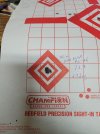Here is a simple summary from varmintal.com that I quoted in post 3 above.
Here they did take into account different powders, same bullet at each barrel length. It was for the .223 as I pointed out in post 3 above.
View attachment 442754
BARREL LENGTH VS ACCURACY.... Richard Lomax at AccurateReloading.com used a Sako S 491 rifle in 223 Remington caliber for the test. He shot 5-shot groups with 3 different powders as he proceeded to shorten the barrel on the rifle. It is difficult to see the trends in the data tables posted here at
http://www.accuratereloading.com/223sb.html. I used Richard Lomax's data and created plot files of the data so the trends can more easily be seen. Here are the complete set of curves I used to view the data and show the trends.
ACCURACY SUMMARY.... Collecting the three average group size curves on one plot shows that a barrel length of between 16 to 17.5" in length
appears to produce the smallest groups and the best accuracy.
Interesting, once you find the best powder for group, it stays that way
at each bbl length in this example. The answers for different powders don't really appear to radically change the optimum barrel length for accuracy ie good groups either.

